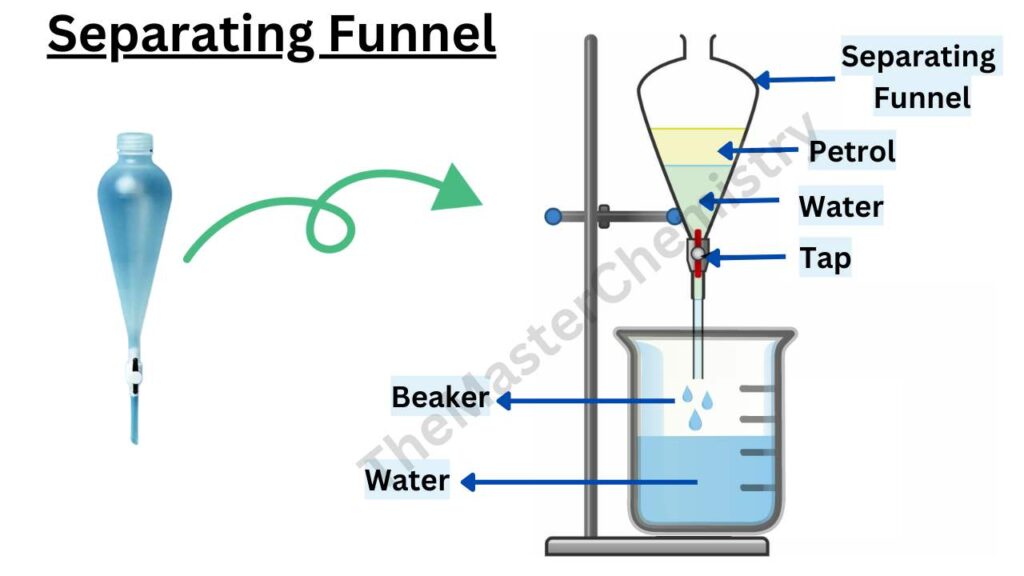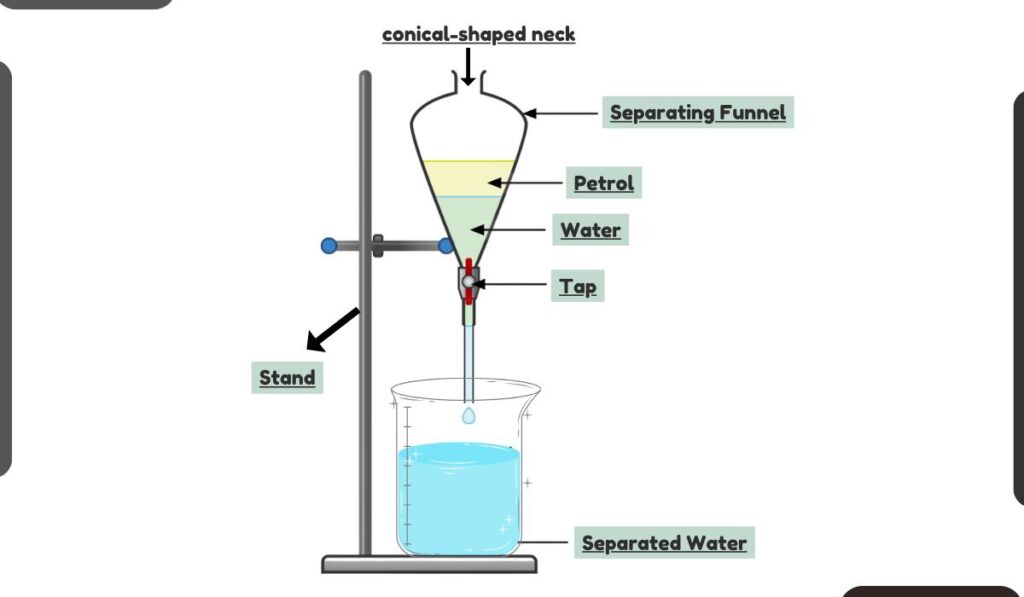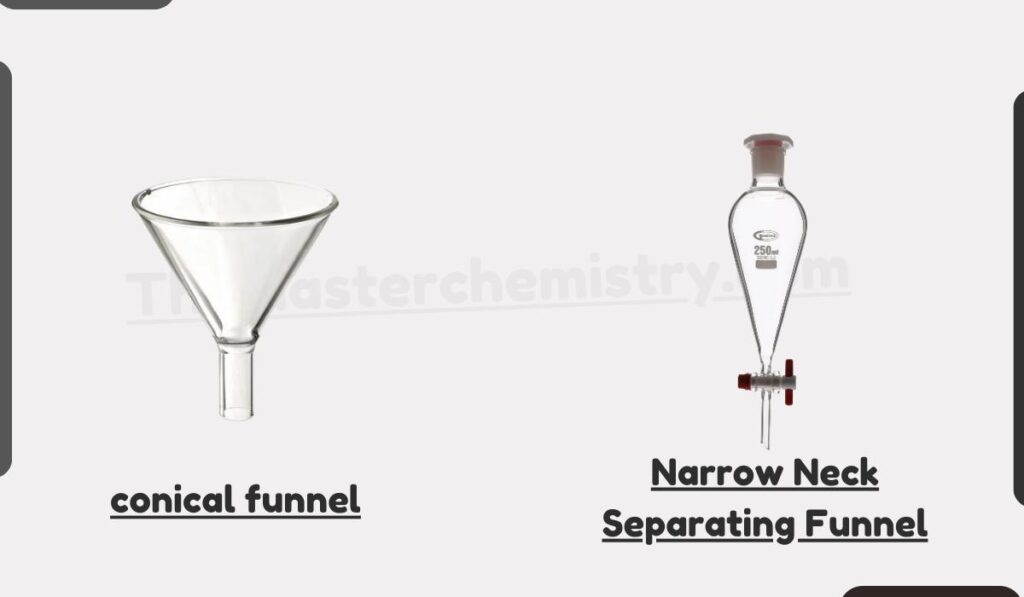What is a Separating Funnel?
Table of Contents
A separating funnel is a tool that is used in chemistry and other sciences to separate a mixture of two liquids into two separated parts. It is used to separate different substances or materials that are mixed together.

Separatory funnel is one of the most important chemistry apparatus for the organic chemists who works on the isolation of compounds from natural products.
Principle of separating funnel
The principle behind separating funnels is based on the density-based separation of immiscible liquids.
The principle that immiscible liquids will separate from each other naturally along with their solutes is the basis of separatory funnels.
Here is the principle of separating two immiscible liquids by separating funnel:
- Add the mixture of kerosene oil and water to the separating funnel.
- Let it stand undisturbed for some time so that the oil and water separate into two layers.
- Open the stopcock of the separating funnel and let the lower layer (water) drain out.
- Close the stopcock and open the other stopcock to drain out the upper layer (kerosene oil).
How does separating funnel work?
The separating funnel works by allowing the two immiscible liquids to separate into two layers. The denser liquid will sink to the bottom of the funnel, and the less dense liquid will float to the top.
To use a separating funnel, first add the liquid you want to separate to the bottom half of the funnel. Then, add the solid or liquid you want to leave behind to the top half of the funnel.
Next, shake the separator vigorously to initiate the separation process. The mixture will then slowly rise until all of the unwanted material has accumulated in the upper half of the separator.
Finally, open the stopcock at the bottom of the funnel to drain out the bottom layer. Then, open the stopcock at the top of the funnel to drain out the top layer.
Also read: Conical Flask in chemistry-Working principle uses
Diagram of separating funnel
It is usually made up of a tall cylindrical shape with a top opening in which is a conical-shaped neck. The neck is smaller than the opening which is the bottom of the funnel.

The neck of the funnel is the narrow part where the material that you want to separate is poured in. The neck is narrower than the opening of the funnel so that the material stays in the neck and the rest of the liquid flows through the opening and out of the funnel.
The reason to use a separating funnel is to ensure that the material or the substance that you want to separate is not mixed with the liquid that is flowing through the funnel.
The separation process is done by the difference in density. When the material is poured into the neck of the funnel, it sinks to the bottom of the funnel and the rest of the liquid flows upwards.
Why is separating funnel narrow at the bottom?
Separating funnels are usually narrow at the bottom because this shape helps to separate the layers of immiscible liquids more effectively.
When the liquids are poured into the funnel, they form two distinct layers, with the denser liquid at the bottom and the less dense liquid on top. T
he narrow bottom of the funnel helps to keep these layers separate and makes it easier to drain off the bottom layer through the tap without disturbing the upper layer.
The narrow bottom of the separating funnel allows the liquids to flow more smoothly and quickly through the tap, making it easier to separate the two layers.
What type of mixture is separated by separating funnel?
Separating funnels are used to separate immiscible liquids, which are liquids that do not mix, and have different densities. These liquids form two distinct layers when they are combined, with the denser liquid at the bottom and the less dense liquid on top.
Oil & water, Gasoline & water, and Motor oil & gasoline are the best examples of immiscible liquids that can be separated through a separating funnel.
What property does the separating funnel exploit for separation?
Separating funnels exploit the difference in density between immiscible liquids in order to separate them. When two immiscible liquids are combined, they form two distinct layers, with the denser liquid at the bottom and the less dense liquid on top. This is because the denser liquid is heavier and sinks to the bottom of the mixture, while the less dense liquid floats to the top.
Commonly used Separating Funnel Types
There are many types of separating funnels available in the market and each type is made for a different purpose.
The conical funnel is the most commonly used and popular kind of separating funnels available. It is used for the separation of different kinds of chemicals like oils, detergents, solvents, inorganic solids, and various minerals.

It is available in two shapes: the wide neck and the narrow neck. The wide neck separating the funnel is wider at the bottom and gets narrower as it goes upwards. It is used for the separation of liquids of different viscosity and densities.
The narrow neck separating funnel is narrower at the bottom and it gets wider as it goes upwards. It is used to separate the denser material from the less dense material. It is usually used for the separation of solids like powders, granules, or particles of solid materials.
8 Uses of Separating Funnels in laboratory
Separating funnels are used for various purposes and functions. Some of these are:
1. Filtration
The separating funnels are used for the filtration of substances for a variety of applications. It is used to remove unwanted substances and filter out the desired materials.
2. Purification
Purification of the materials is done using the separating funnels. Materials that are impure are filtered out and purer materials are allowed to flow.
3. Solvent Extraction
The separating funnels are used to separate materials that are soluble in a solvent. Materials that are soluble in a solvent are easily filtered out by pouring the mixture into the neck of the separating funnel. The rest of the liquid flows through the opening of the funnel.
4. Concentration
Concentration is the process of increasing the amount of the desired material in a mixture or a solution. It is done by removing the unwanted components from a mixture. In this process, the separating funnels are used to separate the materials from the solvent.
5. De-mixing
De-mixing is the process of mixing two different materials and then separating them.
6. Separating Liquids
When different liquids are mixed together in the same container, it is called a homogeneous mixture. It is used for mixing different types of liquids together and then separating them. The separating funnels are used to separate different liquids from one another.
7. Distillation
Distilling is the process of heating the mixture and then separating different materials from the liquid that is heated. A separating funnel is used for distillation purposes as well.
8. Chemical Compounds Separation
Chemical compounds are formed when one element combines with another to form a new compound. They can be obtained as a result of chemical reactions. Separating funnels are used to separate chemical compounds from the liquid that is used for the reaction.
Applications of separating funnel in Industry
Separating funnels are commonly used in a variety of industrial applications where it is necessary to separate immiscible liquids. Some examples of industrial processes in which separating funnels may be used include:
1: Oil and water separation
Separating funnels are often used to separate oil and water in the petroleum and chemical industries. For example, they may be used to separate oil and water in produced water from oil and gas wells, or to separate oil and water in wastewater from industrial processes.
2: Gasoline and water separation
Separating funnels are also used to separate gasoline and water in the petroleum industry. This is important because water can cause corrosion and other problems in gasoline storage tanks and engine fuel systems.
3: Hexane and water separation
Hexane is a common solvent used in the chemical industry, and separating funnels are often used to separate hexane and water after the solvent has been used in a reaction or extraction process.
4: Other applications
Separating funnels may also be used in a variety of other industrial applications where it is necessary to separate immiscible liquids, such as in the production of pharmaceuticals, cosmetics, and food products.
FAQs
-
What is a separating funnel used for?
A separating funnel is used to separate different liquids and solids into different containers.
-
What type of mixture is separated by separating funnel?
A separating funnel is designed to separate two liquids based on their densities. For example, if you have a water-based solution, and another one containing oil, the separation will be done based on the densities of water and oil, respectively.
-
What is an example of a separating funnel?
A separating funnel is an instrument that allows two fluids to be separated. It is usually made of glass, plastic, or metal. The top part is cone-shaped while the bottom part is a flat bottom, concave, or concavity. Both the parts have a tube connecting them to allow the fluids to mix and flow through.
-
why do we use a separating funnel instead of a filter funnel in separating immiscible liquids?
separating funnels are used to separate immiscible liquids, while filter funnels are used to filter solid particles out of a liquid. Separating funnels have a tap at the bottom that allows you to drain off one layer of liquid without disturbing the other, while filter funnels have a porous material at the bottom that catches solid particles as the liquid passes through. These tools are used in different applications and serve different purposes in the laboratory.
-
what is a separatory funnel used for in organic chemistry?
Separatory funnels, also known as separating funnels, are commonly used in organic chemistry to separate mixtures of compounds. They are often used in conjunction with other separation techniques, such as extraction or distillation, and can be used to extract compounds from a mixture, purify compounds, and analyze the composition of mixtures.